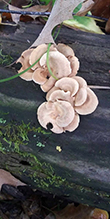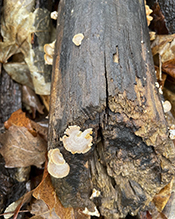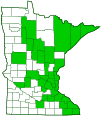Luminescent Panellus
(Panellus stipticus)
Conservation • Description • Habitat • Ecology • Use • Distribution • Taxonomy
Conservation Status |
|
|||||||
| IUCN Red List | not listed |
|||||||
| NatureServe | NNR - Unranked |
|||||||
| Minnesota | not listed |
|||||||
Description |
||
Luminescent Panellus is a common, small, bioluminescent, gilled mushroom. It occurs in Europe, Asia, Western Australia, North America, and Central America. In the United States it occurs east of the Great Plains and west of the Rocky Mountains. It is found usually in clusters or in tightly overlapping tiers on the sides or ends of logs, fallen branches, and stumps. Occasionally it is found on the trunk of a living tree. It grows on hardwoods, especially oak, birch, maple, hickory, pecan, chestnut, and ash, but it has also been reported on eastern white pine and loblolly pine. It obtains its nutrients from decaying wood (saprobic). It causes white rot in wood. New fruiting bodies are formed from September through November, sometimes also in the spring, but they are persistent and can be seen year-round. When it first appears, the cap is convex and tan to pale yellowish-brown. The margins are rolled inward and have fragments of tissue, shredded remnants of the partial veil, hanging from them. The upper surface is dry and is covered with velvety or woolly hairs. As it ages the cap flattens and spreads out from the growing surface parallel to the ground. Mature caps are kidney-shaped, fan-shaped, or semicircular, and are 3⁄16″ to 1¼″ (0.5 to 3.0 cm) in diameter. They are flat below but slightly convex above, being thicker in the middle (plano-convex). The upper surface is often cracked. If exposed to direct sunlight the color changes to cinnamon brown. Caps in diffuse light remain pale. The gills are yellowish-brown, closely spaced, narrow, and often forked. When young, they are broadly attached and may slightly run down the stalk. As the mushroom ages they pull away from the stalk. Between the main gills there are short veins of varying lengths gills that attach to the margin but do not extend all the way to the stalk. There are also numerous cross-veins that connect adjacent gills together. Occasionally, there is no stalk. When present, the stalk is 3⁄16″ to ¾″ (5 to 20 mm) long, ⅛″ to 5⁄16″ (3 to 8 mm) thick. It is attached off-center near or at the side of the cap. It is the same color as the cap or somewhat paler. The flesh is thin, tough, and whitish, pale yellowish, or pale brownish. Its bitter taste and tough texture make it inedible. The spore print is white. |
||
Similar Species |
||
Habitat and Hosts |
||
Mostly hardwoods, especially oak, birch, maple, hickory, pecan, chestnut, and ash; sometimes also eastern white pine and loblolly pine. |
||
Ecology |
||
Season |
||
Mostly September through November, sometimes also in spring |
||
Use |
||
This mushroom has been used in traditional Chinese medicine as a styptic, to stop bleeding. This is the source of the specific epithet stipticus. It was also used as a “violent purgative”. |
||
Distribution |
||||
|
Sources |
|||
| 11/29/2022 | ||||
Occurrence |
||||
Common |
||||
Taxonomy |
|||
| Kingdom | Fungi (Fungi) | ||
| Subkingdom | Dikarya | ||
| Phylum | Basidiomycota (Basidiomycete Fungi) | ||
| Subphylum | Agaricomycotina (Higher Basidiomycetes) | ||
| Class | Agaricomycetes (Mushrooms, Bracket Fungi, Puffballs, and Allies) | ||
| Subclass | Agaricomycetidae | ||
| Order | Agaricales (Common Gilled Mushrooms and Allies) | ||
| Suborder | Marasmiineae | ||
Family |
Mycenaceae | ||
Genus |
Panellus (oysterlings) | ||
Genus Family |
|||
Synonyms |
|||
Agaricus stypticus Merulius stipticus Crepidopus stypticus Lentinus stipticus Panus stipticus Pleurotus stipticus Pocillaria stiptica Rhipidium stipticum |
|||
Common Names |
|||
Astringent Panus Bitter Oyster Luminescent Panellus Stiptic Sungus |
|||
Glossary
Partial veil
A protective covering over the gills or pores of a developing mushroom. At maturity it disappears, collapses into a ring around the stalk, or wears away into a cobwebby covering and ring zone.
Saprobic
A term often used for saprotrophic fungi. Referring to fungi that obtain their nutrients from decayed organic matter.
Visitor Photos |
|||||
Share your photo of this fungus. |
|||||
| This button not working for you? Simply email us at info@MinnesotaSeasons.com. Attach one or more photos and, if you like, a caption. |
|||||
Luciearl |
|||||
 |
|||||
Honey Fae (Farah) |
|||||
Bioluminescent species! |
|||||
 |
|||||
MinnesotaSeasons.com Photos |
|||||
|
|||||

Slideshows |
||

Visitor Videos |
|||
Share your video of this fungus. |
|||
| This button not working for you? Simply email us at info@MinnesotaSeasons.com. Attach a video, a YouTube link, or a cloud storage link. |
|||
Other Videos |
|||
| How I discovered Panellus Stipticus, aka Bitter Oyster Mushroom Reclaimed Man |
|||
About
Oct 1, 2020 |
|||
| Panellus stipticus CUPlantPathPhotoLab |
|||
About
13,429 views Aug 17, 2012 This nondescript little mushroom has gills that glow in the dark. Here you see it in light, then by its own, greenish light. It's common in the forests of northeastern North America. It grows elsewhere as well, but elsewhere (sadly) it doesn't glow. More about it here: |
|||
| A Mushroom That Glows In The Dark? (Panellus stipticus) FreshCap Shorts |
|||
About
Dec 13, 2021 This mushroom really does glow! Panellus stipticus has a green glow, used to attract insects to it's spores. #mushrooms #fungi #mycology |
|||


Created: 11/29/2022
Last Updated:


